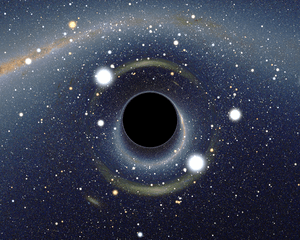Virtual black hole
In quantum gravity, a virtual black hole is a black hole that exists temporarily as a result of a quantum fluctuation of spacetime.[1] It is an example of quantum foam and is the gravitational analog of the virtual electron–positron pairs found in quantum electrodynamics. Theoretical arguments suggest that virtual black holes should have mass on the order of the Planck mass, lifetime around the Planck time, and occur with a number density of approximately one per Planck volume.[2]
The emergence of virtual black holes at the Planck scale is a consequence of the uncertainty relation
where is the radius of curvature of space-time small domain; is the coordinate small domain; is the Planck length; is the Dirac constant; - Newton's gravitational constant; is the speed of light. These uncertainty relations are another form of Heisenberg's uncertainty principle at the Planck scale.
Indeed, these uncertainty relations can be obtained on the basis of Einstein's equations
where is the Einstein tensor, which combines the Ricci tensor, the scalar curvature and the metric tensor, is the cosmological constant, а energy-momentum tensor of matter, is the irrational number originally introduced as the ratio of the circumference of a circle to its diameter, is the speed of light, — Newton's gravitational constant.
In the derivation of his equations, Einstein suggested that physical space-time is Riemannian, ie curved. A small domain of it is approximately flat space-time.
For any tensor field value we may call a tensor density, where - determinant of the metric tensor . The integral is a tensor if the domain of integration is small. It is not a tensor if the domain of integration is not small, because it then consists of a sum of tensors located at different points and it does not transform in any simple way under a transformation of coordinates.[3] Here we consider only small domains. This is also true for the integration over the three-dimensional hypersurface .
Thus, Einstein's equations for small space-time domain can be integrated by the three-dimensional hypersurface . Have[4]
Since integrable space-time domain is small, we obtain the tensor equation
where is the 4-momentum, is the radius of curvature domain.
The resulting tensor equation can be rewritten in another form. Since then
where is the Schwarzschild radius, is the 4-speed, is the gravitational mass. This record reveals the physical meaning of .
In a small area of space-time is almost flat and this equation can be written in the operator form
Then commutator operators and is
From here follow the specified uncertainty relations
Substituting the values of and and cutting right and left of the same symbols, we obtain the Heisenberg uncertainty principle
In the particular case of a static spherically symmetric field and static distribution of matter and have remained
where is the Schwarzschild radius, is the radial coordinate.
Last uncertainty relation allows make us some estimates of the equations of general relativity at the Planck scale. For example, the equation for the invariant interval в in the Schwarzschild solution has the form
Substitute according to the uncertainty relations . We obtain
It is seen that at the Planck scale space-time metric is bounded below by the Planck length, and on this scale, there are real and virtual Planckian black holes.
Similar estimates can be made in other equations of general relativity. For example, analysis of the Hamilton-Jacobi equation for a centrally symmetric gravitational field in spaces of different dimensions (with help of the resulting uncertainty relation) indicates a preference for three-dimensional space for the emergence of virtual black holes (quantum foam).
Prescribed above uncertainty relation valid for strong gravitational fields, as in any sufficiently small domain of a strong field space-time is essentially flat.
If virtual black holes exist, they provide a mechanism for proton decay. This is because when a black hole's mass increases via mass falling into the hole, and then decreases when Hawking radiation is emitted from the hole, the elementary particles emitted are, in general, not the same as those that fell in. Therefore, if two of a proton's constituent quarks fall into a virtual black hole, it is possible for an antiquark and a lepton to emerge, thus violating conservation of baryon number.[2]
The existence of virtual black holes aggravates the black hole information loss paradox, as any physical process may potentially be disrupted by interaction with a virtual black hole.[5]
See also
References
- ↑ S. W. Hawking(1995)"Virtual Black Holes"
- 1 2 Fred C. Adams, Gordon L. Kane, Manasse Mbonye, and Malcolm J. Perry (2001), Proton Decay, Black Holes, and Large Extra Dimensions, Intern. J. Mod. Phys. A, 16, 2399.
- ↑ P.A.M.Dirac(1975), General Theory of Relativity, A Wilay Interscience Publication, p.37
- ↑ A.P.Klimets(2012) "Postigaya mirozdanie", LAP LAMBERT Academic Publishing, Deutschland
- ↑ The black hole information paradox, Steven B. Giddings, arXiv:hep-th/9508151v1.
